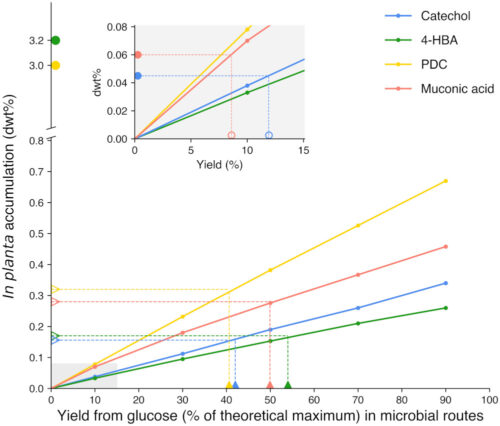07/19/2022
In Planta Accumulation of Value-added Bioproducts Compared with Microbial Production Routes
A step toward establishing targets for a cost-competitive bioeconomy

Comparison of minimum selling prices ($/kg) between in planta accumulation and microbial routes to bioproducts, using the base case ethanol selling price ($1.44/liter of gasoline equivalent) for lignocellulosic biorefineries that convert residual biomass after bioproduct extraction from plants.
[Reprinted under a Creative Commons license (CC BY-NC-ND) from Yang et al. 2020. DOI:10.1073/pnas.2000053117]
The Science
Bioenergy crops can be engineered to accumulate a range of high-value bioproducts in planta that can be fractionated and recovered for sale from biorefineries, thereby improving the cost-competitiveness of biofuels. But the economics of this approach have not previously been compared with microbial production routes. DOE Joint BioEnergy Institute (JBEI) research showed that accumulating bioproducts in bioenergy crops at levels as low as less than 1% can improve biorefinery economics across a wide range of commodity prices. In addition, cost-comparisons between plant and microbial systems demonstrate that in planta accumulation can be competitive with microbial production routes.
The Impact
The study provides generalizable insights into breakeven points between plants and microbes, assuming residual plant biomass can be converted to biofuel. Both plants and microbes have an important role in producing bioproducts.
Summary
JBEI researchers used technoeconomic assessment to compare in planta and microbial production of four exemplar bioproducts in biorefineries: catechol; muconic acid; 4-hydroxybenzoic acid (4-HBA); and 2-pyrone-4,6-dicarboxylic acid (PDC). In planta mass accumulation ranging from 0.1 to 0.3 dry weight % can achieve costs comparable to microbial routes operating at 40 to 55% of maximum theoretical yields from glucose. The comparative analysis revealed that accumulation rates of 4-HBA and PDC in engineered plants vastly outperform microbial routes, but muconic acid and catechol are currently more attractive when produced microbially using a sugar feedstock.
Principal Investigator
Corinne D. Scown
Lawrence Berkeley National Laboratory
cdscown@lbl.gov
BER Program Manager
Shing Kwok
U.S. Department of Energy, Biological and Environmental Research (SC-33)
Biological Systems Science Division
shing.kwok@science.doe.gov
Funding
This work was part of the DOE Joint BioEnergy Institute, supported by the DOE Office of Science, Biological and Environmental Research program, through contract DE-AC02-05CH11231 between Lawrence Berkeley National Laboratory and DOE. This study was also supported by the DOE Office of Energy Efficiency and Renewable Energy, Bioenergy Technologies Office.
References
Yang, M., et al. 2020. “Accumulation of High-Value Bioproducts In Planta Can Improve the Economics of Advanced Biofuel,” Proceedings of the National Academy of Sciences 117(15), 8639–48. DOI:10.1073/pnas.2000053117.
Yang, M., et al. 2022. “Comparing In Planta Accumulation with Microbial Routes to Set Targets for a Cost-Competitive Bioeconomy,” Proceedings of the National Academy of Sciences 119(30), e2122309119. DOI:10.1073/pnas.2122309119.
